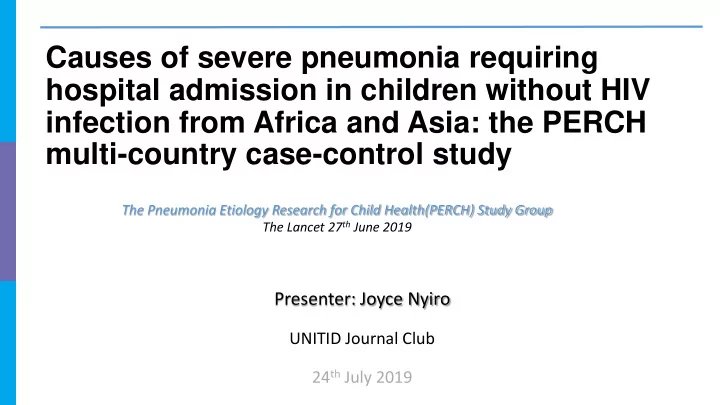

Causes of severe pneumonia requiring hospital admission in children without HIV infection from Africa and Asia: the PERCH multi-country case-control study The Pneumonia Etiology Research for Child Health(PERCH) Study Group The Lancet 27 th June 2019 Presenter: Joyce Nyiro UNITID Journal Club 24 th July 2019
Background Pneumonia greatest cause of death in under five. Annually accounts for 12.8% deaths Significant reduction over years (1.7 million in 1990 to 0.7million in 2015)
Pneumonia aetiology: Kenya before PERCH study No pathogen identified S. pneumoniae Changes since 1. Introduction of HiB vaccines S. aureus (2001) Gram-negative 2. Introduction of PCV (2011) bacteria M. tuberculosis H. influenzae RSV and respiratory viruses Figure: Etiology of severe pneumonia in children in developing countries. Qualitative representation of the combined results of vaccine probe analyses (12, 113), studies of blood and lung aspirate cultures (14, 111, 153 – 155), and virus studies (128, 156) in predominantly HIV- uninfected children. Scott et al. J Clin Invest 2008: 118:1291-300
Study Obje jectives Characterize the causes of severe childhood pneumonia requiring hospital admission (updated evidence). Provide rigorous data that would inform future prevention and treatment strategies in LMIC settings .
PERCH study sites (2 (2011-2014) Data centre Dhaka & Bamako Matlab Basse Nakhon Phanom & Sa Kaeo Kilifi Lusaka Soweto
Case defi finition (W (WHO 2005) Severe pneumonia Cough or difficulty breathing with lower chest wall indrawing. Very severe pneumonia Cough or difficulty breathing and at least one of the following signs: central cyanosis, difficulty breastfeeding or drinking, vomiting everything, convulsions, lethargy, unconsciousness, or head nodding.
Study Design (1 (15 Aug 2011-30 Jan 2014)
Screening and enrolment Exclusion Criteria: Re-admission within 14 days, Discharged as PERCH case within 30 days Non resident of catchment area Matching: Target 25 controls per month, minimum 100 cases/year 1-<6 months 6-<12 months 12-<24 months 24-<59 months Case assessments within 24 hours of admission
Procedures Samples at enrollment: Cases and Controls Oropharyngeal (NP-OP), urine, and blood specimens Cases only Blood cultures, induced sputum, lung aspirate, pleural fluid, and gastric aspirates Chest x-rays Laboratory 33-pathogen multiplex quantitative PCR for NP swabs, NPS cultures for SPN, Mycobacterium cultures (Pleural fluid, Induced sputum &lung aspirate)
Statistical Analysis Single data entry into a centralised electronic data capture system. Primary analysis : Estimate the aetiological fraction of severe and very severe pneumonia among cases with a positive chest x-ray. PERCH Integrated Analysis model assumption: All cases had a lung infection. Missing data imputed during model estimation by use of standard Bayesian methods. Logistic regression methods to compare cases and controls. Focus pathogen if etiology >5% (n=7) or >2% for treatable by antibiotics.
Results: Enrolment and specimen profile
Results: Blood culture results by site
Top 10 causes of f Severe Pneumonia (A (All ages) 10 pathogens caused the vast majority (about 8 in 10 cases) accounting 79% of etiological fraction:
Sit ite-specific ic cumula lativ ive contri ribution of f 10 most common pathogens
Top 10 causes of f Severe Pneumonia(Under 1 yr yr) 10 pathogens caused the vast majority (about 8 in 10 cases) accounting 79% of etiological fraction:
Top 10 causes of f Severe Pneumonia(Over 1 yr yr) 10 pathogens caused the vast majority (about 8 in 10 cases) accounting 79% of etiological fraction:
PERCH study Dis iscussio ion on pneumonia etio iology RSV an important prevention and therapeutic target among infants. NP-OP specimens remain of substantial importance for pneumonia aetiology studies. Novel analytical method overcame limitations of traditional approach. Need to adjust pneumonia treatment algorithms. Role of co-infection.
What is known as cause of severe pneumonia in Kenya? OLD NEW NoA� Other� TB� No pathogen PCP� 1%� 4%� Inf� 2%� identified 2%� 3%� S. pneumoniae S.� Pneumo� 4%� PV-EV� 4%� RSV� 40%� HiB� 6%� S. aureus PIV� Gram-negative 8%� bacteria M. tuberculosis hMPV� 11%� Rhino� H. influenzae 15%� RSV and respiratory viruses Figure 2. Etiology of severe pneumonia in children in developing countries. Qualitative representation of the Otieno J & Scott A et al Unpublished data, Kilifi combined results of vaccine probe analyses (12, 113), studies of blood and lung aspirate cultures (14, 111, 153 – 155), and virus studies (128, 156) in predominantly HIV- uninfected children. Scott et al. J Clin Invest 2008: 118:1291-300
Relevance of paper to my PhD project Enough evidence that RSV is a leading RESVAX(F-post fusion), Leading cause of severe pneumonia among children <5yrs. Maternal Characteristics 1. Gest age at ANC No licensed childhood RSV vaccines to attendance 2. Clinical/obstetric date events 3.Demographic factors Maternal RSV vaccine as an alternative 4.Immunological strategy for prevention in focus Trans-placental transfer of Results of a phase 3 clinical trial antibodies announced Need to understand the programmatic 1. Birth outcome factors that would influence it’s success 2. Duration of protection in Kenya Vaccine effectiveness
Questions and Critique
Recommend
More recommend